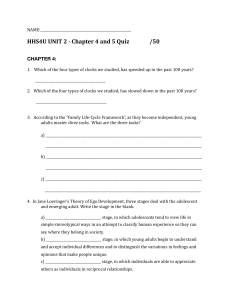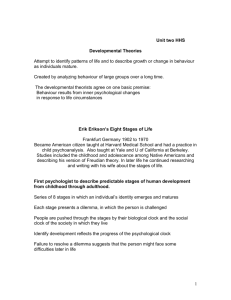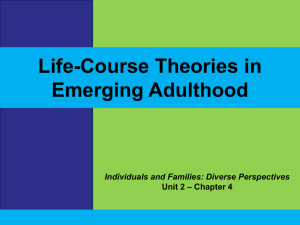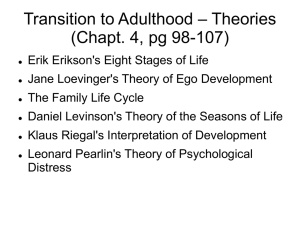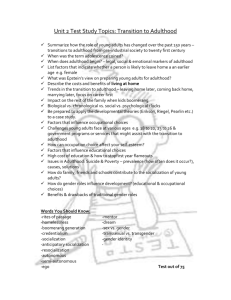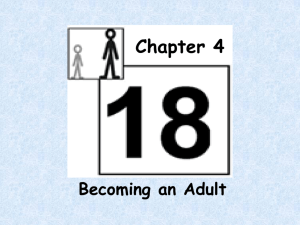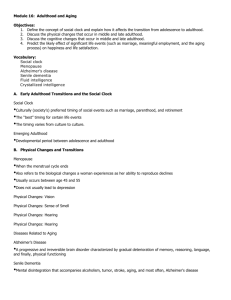Life-Course (Developmental) Theories
advertisement
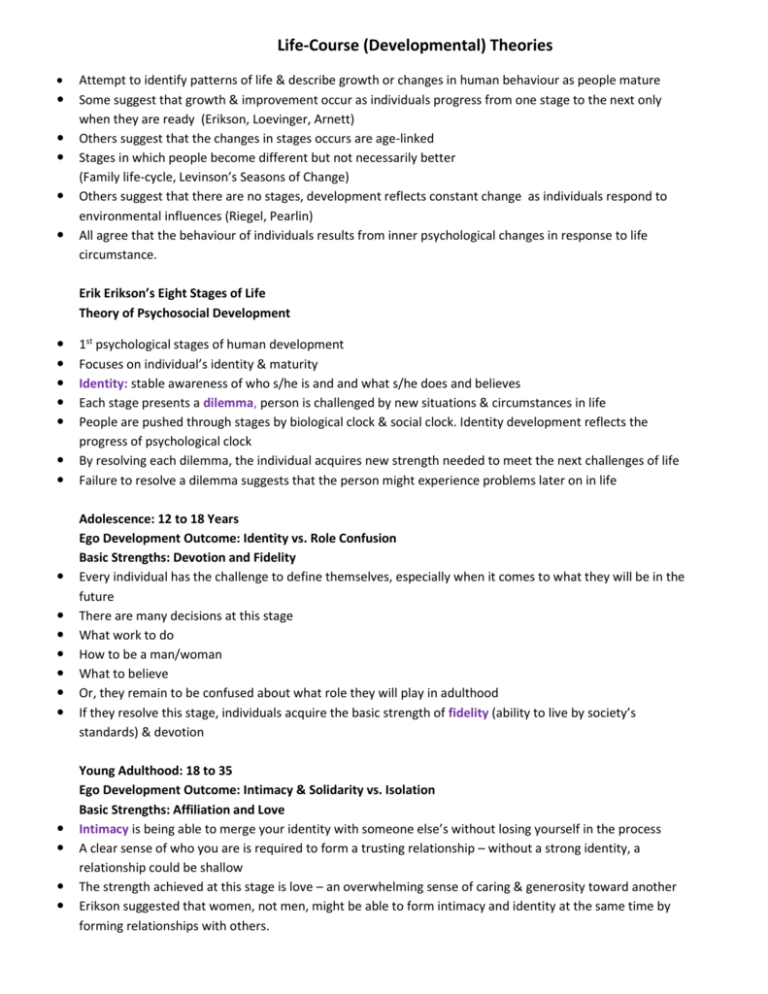
Life-Course (Developmental) Theories Attempt to identify patterns of life & describe growth or changes in human behaviour as people mature Some suggest that growth & improvement occur as individuals progress from one stage to the next only when they are ready (Erikson, Loevinger, Arnett) Others suggest that the changes in stages occurs are age-linked Stages in which people become different but not necessarily better (Family life-cycle, Levinson’s Seasons of Change) Others suggest that there are no stages, development reflects constant change as individuals respond to environmental influences (Riegel, Pearlin) All agree that the behaviour of individuals results from inner psychological changes in response to life circumstance. Erik Erikson’s Eight Stages of Life Theory of Psychosocial Development 1st psychological stages of human development Focuses on individual’s identity & maturity Identity: stable awareness of who s/he is and and what s/he does and believes Each stage presents a dilemma, person is challenged by new situations & circumstances in life People are pushed through stages by biological clock & social clock. Identity development reflects the progress of psychological clock By resolving each dilemma, the individual acquires new strength needed to meet the next challenges of life Failure to resolve a dilemma suggests that the person might experience problems later on in life Adolescence: 12 to 18 Years Ego Development Outcome: Identity vs. Role Confusion Basic Strengths: Devotion and Fidelity Every individual has the challenge to define themselves, especially when it comes to what they will be in the future There are many decisions at this stage What work to do How to be a man/woman What to believe Or, they remain to be confused about what role they will play in adulthood If they resolve this stage, individuals acquire the basic strength of fidelity (ability to live by society’s standards) & devotion Young Adulthood: 18 to 35 Ego Development Outcome: Intimacy & Solidarity vs. Isolation Basic Strengths: Affiliation and Love Intimacy is being able to merge your identity with someone else’s without losing yourself in the process A clear sense of who you are is required to form a trusting relationship – without a strong identity, a relationship could be shallow The strength achieved at this stage is love – an overwhelming sense of caring & generosity toward another Erikson suggested that women, not men, might be able to form intimacy and identity at the same time by forming relationships with others. Middle Adulthood: 35 to 55 or 65 Ego Development Outcome: Generativity vs. Self absorption or Stagnation Basic Strengths: Production and Care Adults focus on their contribution to society The challenge is to decide how to make individual contribution to society Develop the strength of caring Typically, people develop this by having children Others develop it by completing good works Klaus Riegel’s Dimensions of Development Development occurs as individuals adjust in response to the interaction of both internal and external changes Biological and social clock Integrates internal physical and psychological dimensions with external social and environmental dimensions Explains how the pace of adult development reflects the changing social clock Early application of ecological systems theory 4 Interrelated Internal/External Dimensions of Development 1. Individual psychological Dimension • emotional maturity and independence • mental process maturity 2. Individual Biological Dimensions • Physical/sexual maturity 3. Cultural sociological Dimension • Expectations/opportunities that each society defines for individuals 4. Environmental Dimension • Physical, economic/political environment in which the individual lives Development occurs when change in one dimension requires an adjustment in another Loevinger’s Theory of Ego Development Identified stages towards a higher level of development 10 stages in Ego (I myself) formation (Freud’s understanding of self/identity) Ego development begins in infancy with the understanding that you are your own person Autonomous Self : Full Ego development Self-reliant person who accepts oneself as unique Young adults are at transitional self aware level between conformist and conscientious stages 3 Stages adolescent and emerging adult Conformist: adolescents see things in simple stereotypical ways B&W, see where they fit in Self-Aware: see and accept differences, understanding what makes individuals unique Clear pictures of themselves must be seen first before intimate relationships can be formed with others Conscientious: appreciate others as individuals in reciprocal relationships Development is determined by the individual’s psychological clock. Few achieve full development Chronological age and social environment do not play a role The Family Life Cycle Framework Carter & McGoldrick Adulthood: stage in which individuals are launched from their families of origin Parents and children must separate from one another so young adults can accept emotional responsibility for themselves Focused on early adulthood in the context of marriage and parenthood Used in family therapy 3 Developmental Tasks: Young adults master 3 tasks as they become independent: 1. Form an identity that is separate from the family o Individuation: take, leave, create what they want 2. Develop new intimate relationships with peers outside the family 3. Make a tentative commitment to career/workplace All of these tasks must be mastered to create self sufficient adults Pearlin’s Theory of Psychological Distress Development unique to individuals yet occurs in common patterns Disagreed with stage theories Adulthood is a lifetime of continuous change in which individuals might experience occasional stability/ required by distress (stimulus that requires a psychological response) 4 elements that determine individual paths: Individual characteristics (gender, race, intelligence, family background, personality, education) Range of skills to cope with stress/change Availability of support networks Nature and timing of stress requiring response Cohort effect: changes in behaviour result from socialized responses to a common social clock rather than from age-linked inner changes. Levinson’s Theory of the Seasons of Life Early Adulthood lasts 25 yrs (17-33) Life structure is built leaving behind adolescence Changes in attachment separating from family origin and allowing room for new adult relationships Entering the Adult World (22-28) 4 Major tasks: 1. Forming a dream and putting it into life structure 2. Forming mentor relationships 3. Forming an occupation 4. Forming loving relationships, marriage, family Dream: individual’s sense of self in the adult world is the core of life structure. This can vary. Individuals must figure out if it is satisfying or realistic Transition (28-33) Re-evaluate life structures Get real Arnett’s Theory of Emerging Adulthood Reasons for a distinct stage in the life course following adolescence and before adulthood Individuals 18-25 in industrialized countries are not yet entering adult roles, but are no longer adolescents Instability, semi-autonomous moving in and out of parental home, without financial independence Most feel they have not achieved adult status (accepting responsibility for one’s self, independent decision making, financial independence) Created by post-industrial society in the late 20th century offering opportunities for more extensive identity exploration (love, work, worldviews)separate from and prior to making decisions for adulthood
